The Influence of Argon Plasma on Organic Perovskite MAPbI3 Film Doped with Inorganic Perovskite CsPbI3 Quantum Dots (QDs)
Abstract
:1. Introduction
2. Materials and Methods
2.1. Materials
2.2. Solution Preparation and Synthesis for Cs-Oleate Precursor, CsPbI3 QDs, and CH3NH3PbI3
2.3. Synthesis Process of CH3NH3PbI3
2.4. Synthesis Process of Cs-Oleate Precursor
2.5. Synthesis Process of CsPbI3 QDs
2.6. Purification Process of CsPbI3 QDs
2.7. Fabrication of Thin Films
2.8. Characteristic Measurements
3. Results and Discussion
4. Conclusions
Author Contributions
Funding
Institutional Review Board Statement
Informed Consent Statement
Data Availability Statement
Conflicts of Interest
References
- Chen, Q.; de Marco, N.; Yang, Y.; Song, T.; Chen, C.; Zhao, H.; Hong, Z.; Zhou, H.; Yang, Y. Under the spotlight: The organ-ic–inorganic hybrid halide perovskite for optoelectronic applications. Nano Today 2015, 10, 355–396. [Google Scholar] [CrossRef] [Green Version]
- Song, T.B.; Chen, Q.; Zhou, H.; Jiang, C.; Wang, H.H.; Yang, Y.M.; Liu, Y.; Yang, Y. Perovskite solar cells: Film formation and properties. J. Mater. Chem. A 2015, 3, 9032–9050. [Google Scholar] [CrossRef]
- Zhou, D.; Zhou, T.; Tian, Y.; Zhu, X.; Tu, Y. Perovskite-Based Solar Cells: Materials, Methods, and Future Perspectives. J. Nanomater. 2018, 2018, 8148072. [Google Scholar] [CrossRef]
- Wang, H.; Kim, D.H. Perovskite-based photodetectors: Materials and devices. Chem. Soc. Rev. 2017, 46, 5204–5236. [Google Scholar] [CrossRef] [PubMed]
- Zheng, C.; Rubel, O. Unraveling the water degradation mechanism of CH3NH3PbI3. J. Phys. Chem. C 2019, 123, 19385–19394. [Google Scholar] [CrossRef] [Green Version]
- Chi, W.; Banerjee, S.K. Achieving Resistance against Moisture and Oxygen for Perovskite Solar Cells with High Efficiency and Stability. Chem. Mater. 2021, 33, 4269–4303. [Google Scholar] [CrossRef]
- Li, M.; Zhang, Y.; Tang, X.; Li, J.; Wang, S.; Li, T.; Wang, Q.; Zhao, H.; Li, Q.; Yao, J. Improving performance of hybrid perov-skite/graphene-based photodetector via hot carriers injection. J. Alloys Compd. 2022, 895, 162496. [Google Scholar] [CrossRef]
- Deng, X.; Cao, Z.; Li, C.; Wang, S.; Hao, F. Benzotriazole derivative inhibits nonradiative recombination and im-proves the UV-stability of inverted MAPbI3 perovskite solar cells. J. Energy Chem. 2022, 65, 592–599. [Google Scholar] [CrossRef]
- Huang, P.H.; Wang, C.W.; Lien, S.Y.; Lee, K.W.; Wang, N.F.; Huang, C.J. Investigation of the Stability of Me-thylammonium Lead Iodide (MAPbI3) Film Doped with Lead Cesium Triiodide (CsPbI3) Quantum Dots under an Oxygen Plasma Atmosphere. Molecules 2021, 26, 2678. [Google Scholar] [CrossRef]
- Chen, L.; Cao, H.; Wang, S.; Luo, Y.; Tao, T.; Sun, J.; Zhang, M. Efficient air-stable perovskite solar cells with a (FAI) 0.46 (MAI) 0.40 (MABr) 0.14 (PbI2) 0.86 (PbBr2) 0.14 active layer fabricated via a vacuum flash-assisted method under RH> 50%. RSC Adv. 2019, 9, 10148–10154. [Google Scholar] [CrossRef] [Green Version]
- Clark, C.P.; Voigt, B.; Aydil, E.S.; Holmes, R.J. Carrier-gas assisted vapor deposition for highly tunable mor-phology of halide perovskite thin films. Sustain. Energy Fuels 2019, 3, 2447–2455. [Google Scholar] [CrossRef]
- Shekargoftar, M.; Pospisil, J.; Dugáček, J.; Weiter, M.; Homola, T. Surface Property Tuning of Methylammonium Lead Iodide by Plasma for Use in Planar Perovskite Solar Cells. ACS Omega 2020, 5, 18384–18390. [Google Scholar] [CrossRef]
- Oka, D.; Hirose, Y.; Fukumura, T.; Hasegawa, T. Heteroepitaxial growth of perovskite CaTaO2N thin films by ni-trogen plasma-assisted pulsed laser deposition. Cryst. Growth Des. 2014, 14, 87–90. [Google Scholar] [CrossRef]
- Xiao, X.; Bao, C.; Fang, Y.; Dai, J.; Ecker, B.R.; Wang, C.; Lin, Y.; Tang, S.; Liu, Y.; Deng, Y.; et al. Argon Plasma Treatment to Tune Perovskite Surface Composition for High Efficiency Solar Cells and Fast Photodetectors. Adv. Mater. 2018, 30, 5176. [Google Scholar] [CrossRef]
- Moreno-Romero, P.M.; Corpus-Mendoza, A.N.; Millán-Franco, M.A.; Rodríguez-Castañeda, C.A.; Torres-Herrera, D.M.; Liu, F.; Hu, H. Roughness and structural modification of PbI2 thin films by isopropanol treatment to improve me-thylammonium lead halide formation and solar cell efficiency. J. Mater. Sci. Mater. Electron. 2019, 30, 17491–17503. [Google Scholar] [CrossRef]
- Smith, A.; Mohs, A.; Nie, S. Tuning the optical and electronic properties of colloidal nanocrystals by lattice strain. Nat. Nanotechnol. 2008, 4, 56–63. [Google Scholar] [CrossRef] [Green Version]
- Luo, S.; Kazes, M.; Lin, H.; Oron, D. Strain-induced type II band alignment control in CdSe nanoplate-let/ZnS-sensitized solar cells. J. Phys. Chem. C 2017, 121, 11136–11143. [Google Scholar] [CrossRef]
- Shekargoftar, M.; Jurmanová, J.; Homola, T. A study on the effect of ambient air plasma treatment on the proper-ties of methylammonium lead halide perovskite films. Metals 2019, 9, 991. [Google Scholar] [CrossRef] [Green Version]
- Wang, T.; Zhang, H.; Hou, S.; Zhang, Y.; Li, Q.; Zhang, Z.; Gao, H.; Mao, Y. Facile Synthesis of Methylammonium Lead Iodide Perovskite with Controllable Morphologies with Enhanced Luminescence Performance. Nanomaterials 2019, 9, 1660. [Google Scholar] [CrossRef] [Green Version]
- Da Silva Filho, J.M.C.; Ermakov, V.A.; Marques, F.C. Perovskite thin film synthesised from sputtered lead sul-phide. Sci. Rep. 2018, 8, 1563. [Google Scholar] [CrossRef]
- Lien, S.-Y.; Chen, Y.-H.; Chen, W.-R.; Liu, C.-H.; Huang, C.-J. Effect of Growth Temperature on the Characteristics of CsPbI3-Quantum Dots Doped Perovskite Film. Molecules 2021, 26, 4439. [Google Scholar] [CrossRef]
- Liu, T.; Hu, Q.; Wu, J.; Chen, K.; Zhao, L.; Liu, F.; Wang, C.; Lu, H.; Jia, S.; Russell, T.; et al. Mesoporous PbI2 Scaffold for High-Performance Planar Heterojunction Perovskite Solar Cells. Adv. Energy Mater. 2015, 6, 1501890. [Google Scholar] [CrossRef]
- Yousefi, R.; Soofivand, F.; Salavati-Niasari, M. PbHgI4/HgI2 nanocomposite: Simple synthesis, characterization and electrochemical and optical properties. J. Mater. Sci. Mater. Electron. 2016, 28, 2615–2623. [Google Scholar] [CrossRef]
- Qiao, L.; Fang, W.H.; Prezhdo, O.V.; Long, R. Suppressing Oxygen-Induced Deterioration of Metal Halide Perov-skites by Alkaline Earth Metal Doping: A Quantum Dynamics Study. J. Am. Chem. Soc. 2022, 144, 5543–5551. [Google Scholar] [CrossRef] [PubMed]
- Kong, W.; Rahimi-Iman, A.; Bi, G.; Dai, X.; Wu, H. Oxygen Intercalation Induced by Photocatalysis on the Surface of Hybrid Lead Halide Perovskites. J. Phys. Chem. C 2016, 120, 7606–7611. [Google Scholar] [CrossRef]
- Watthage, S.C.; Song, Z.; Liyanage, G.K.; Phillips, A.B.; Heben, M.J. Investigation on the nucleation and growth mechanisms of perovskite formation in the two-step solution process. In Proceedings of the 2016 IEEE 43rd Photovoltaic Specialists Conference (PVSC), Portland, OR, USA, 5–10 June 2016. [Google Scholar]
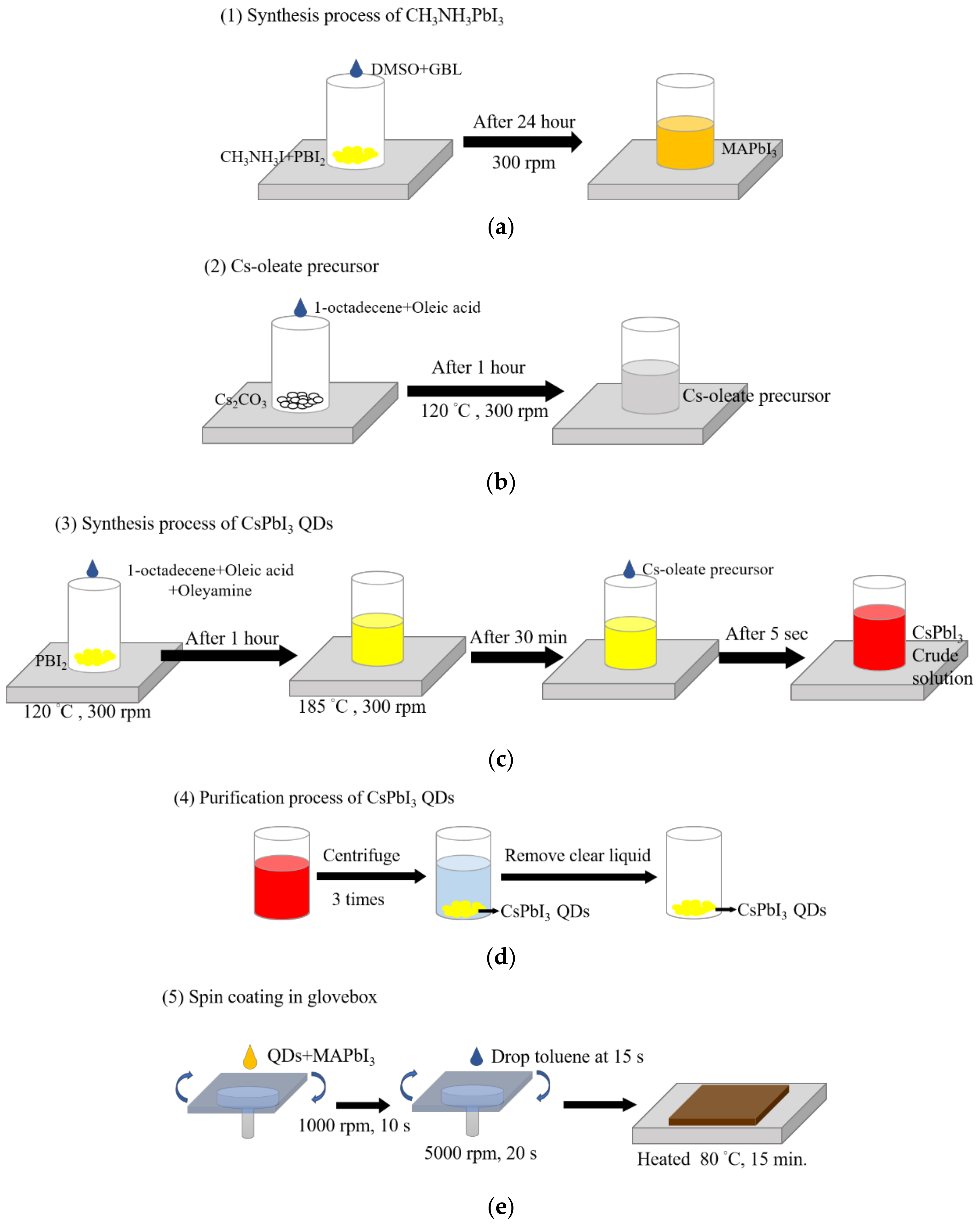
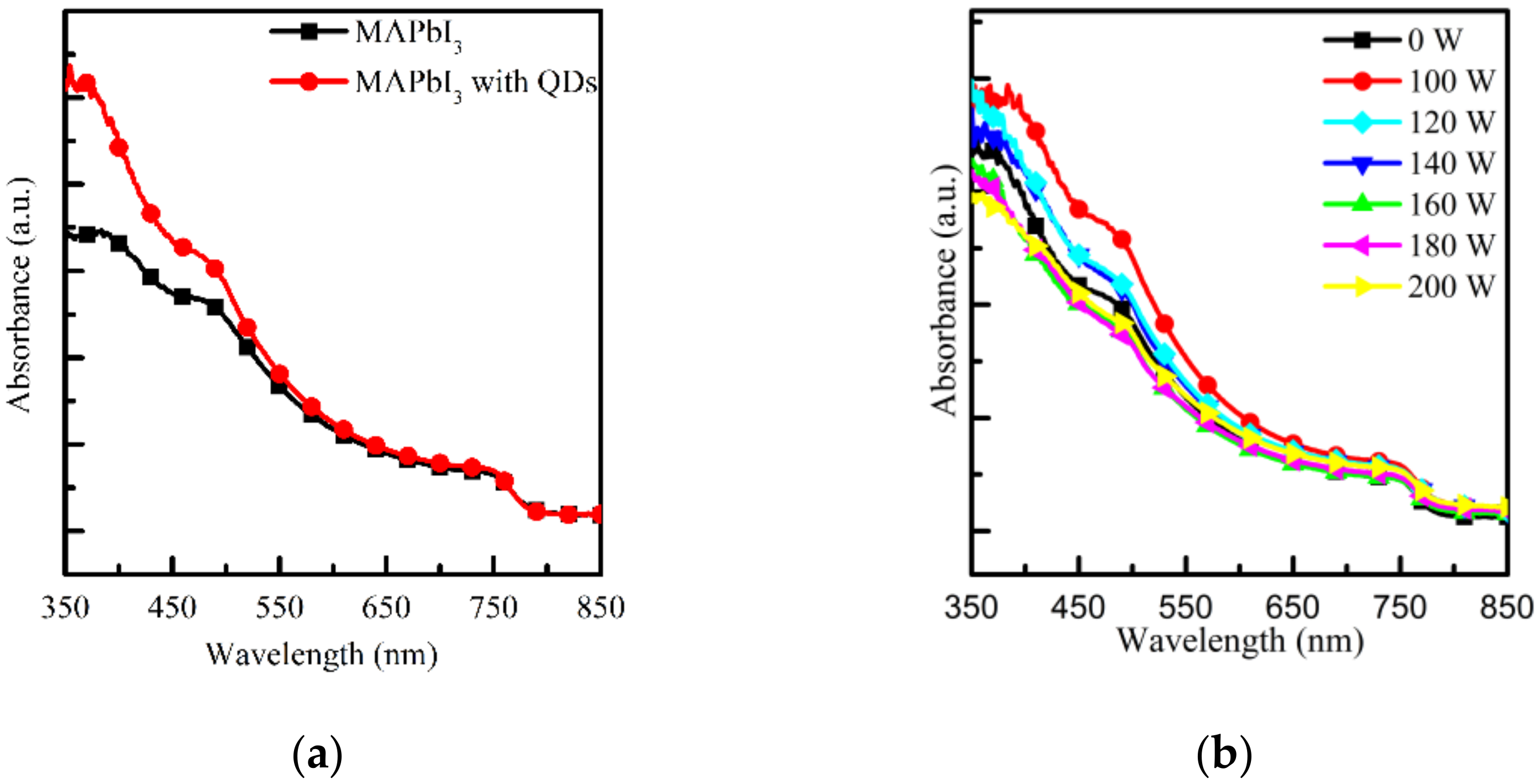
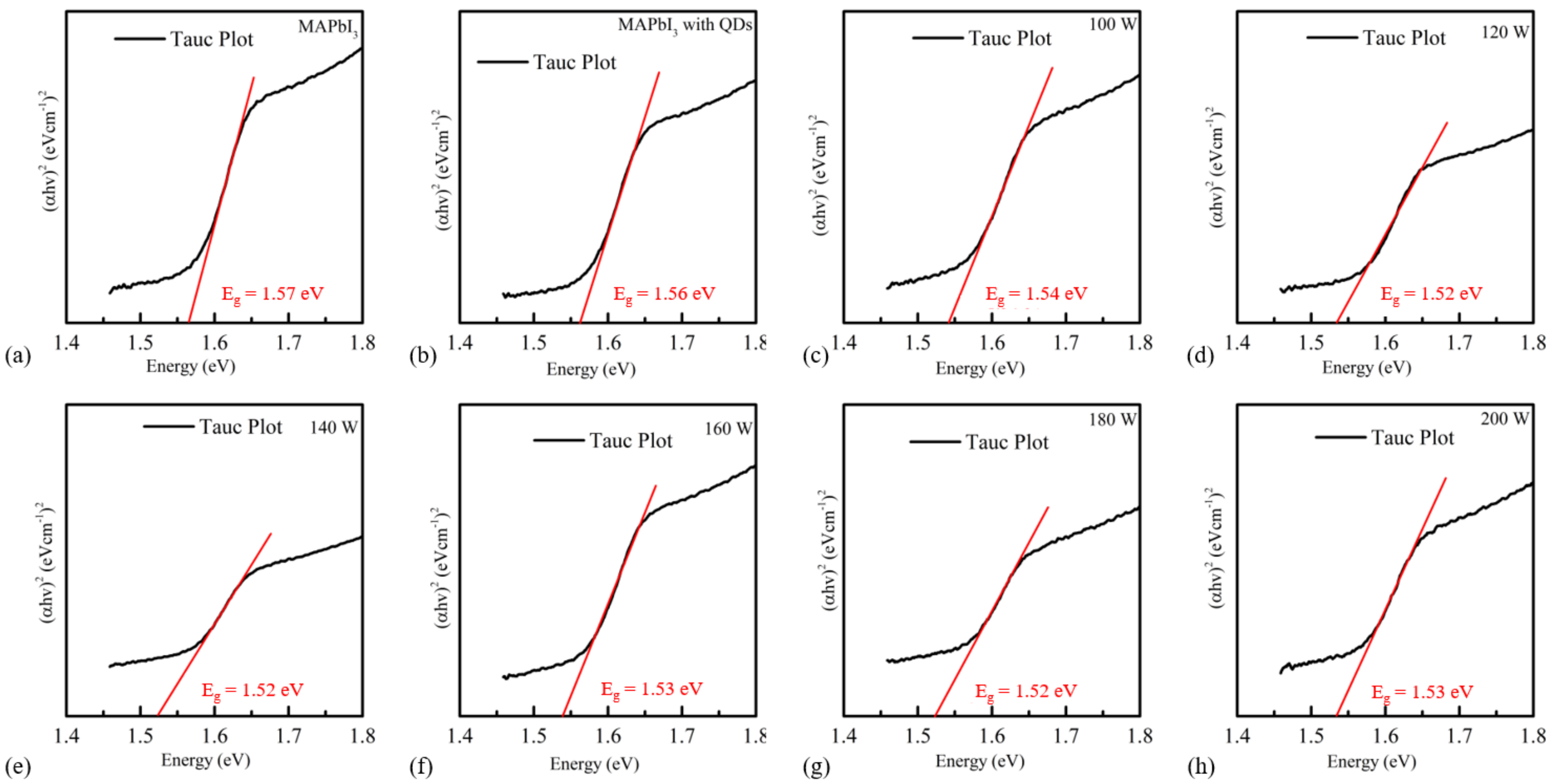
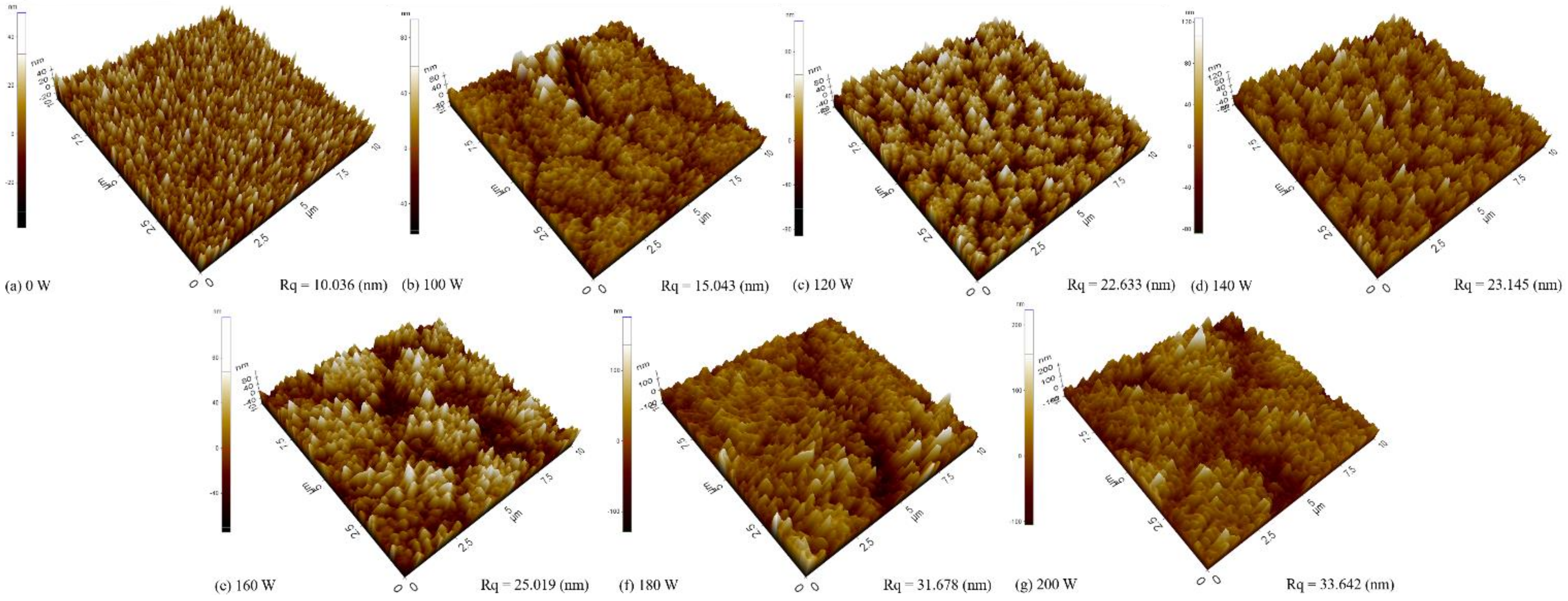
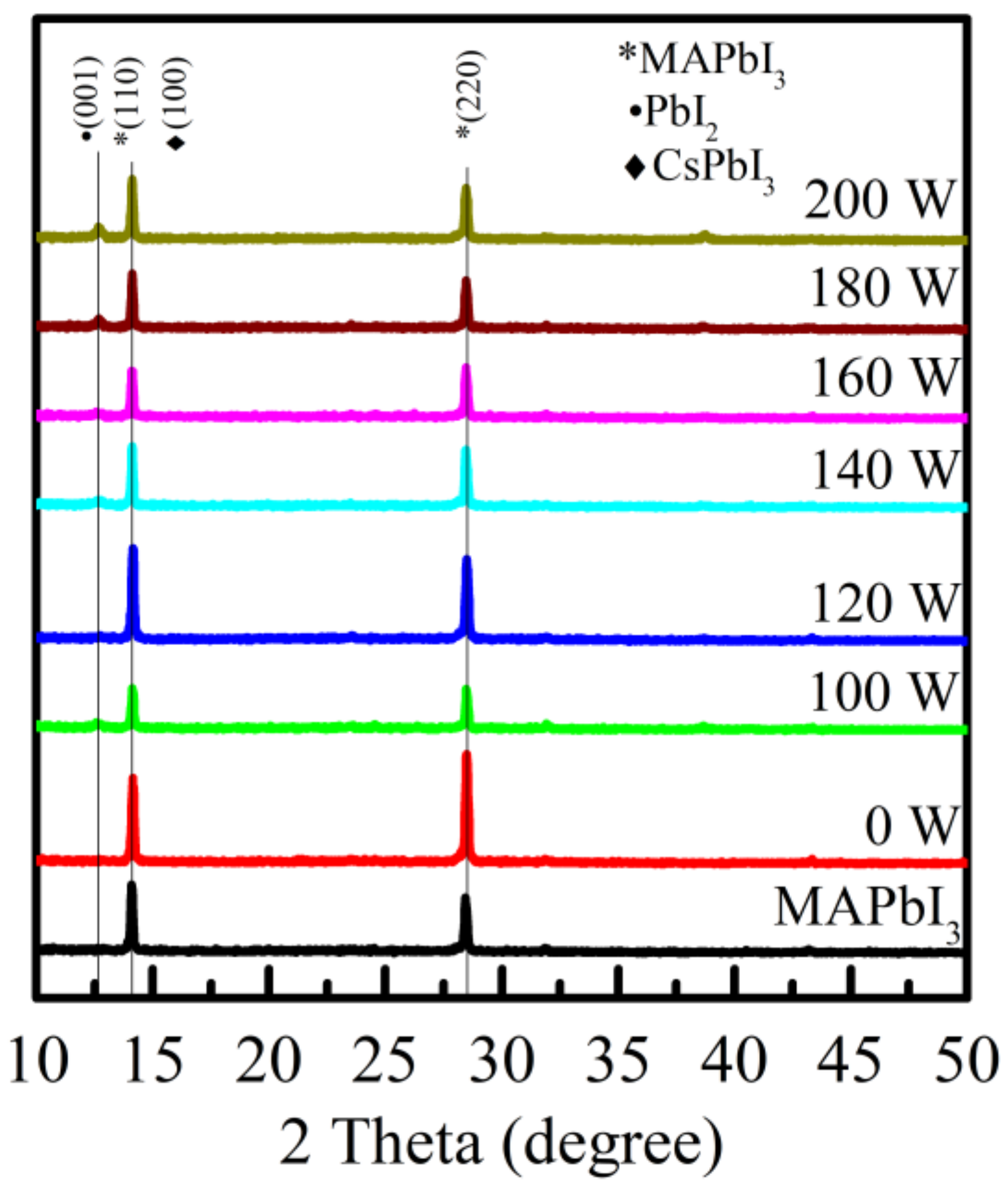
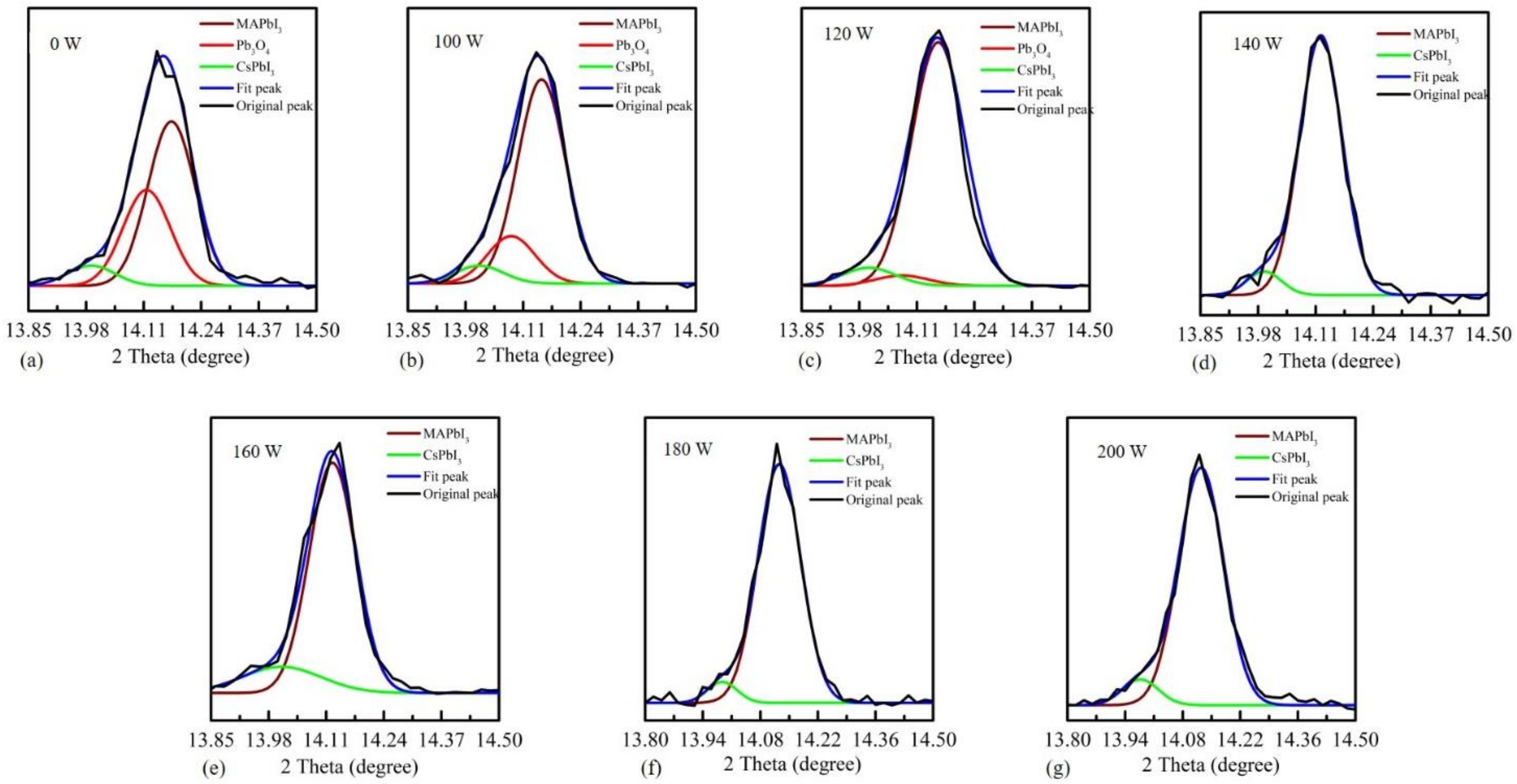

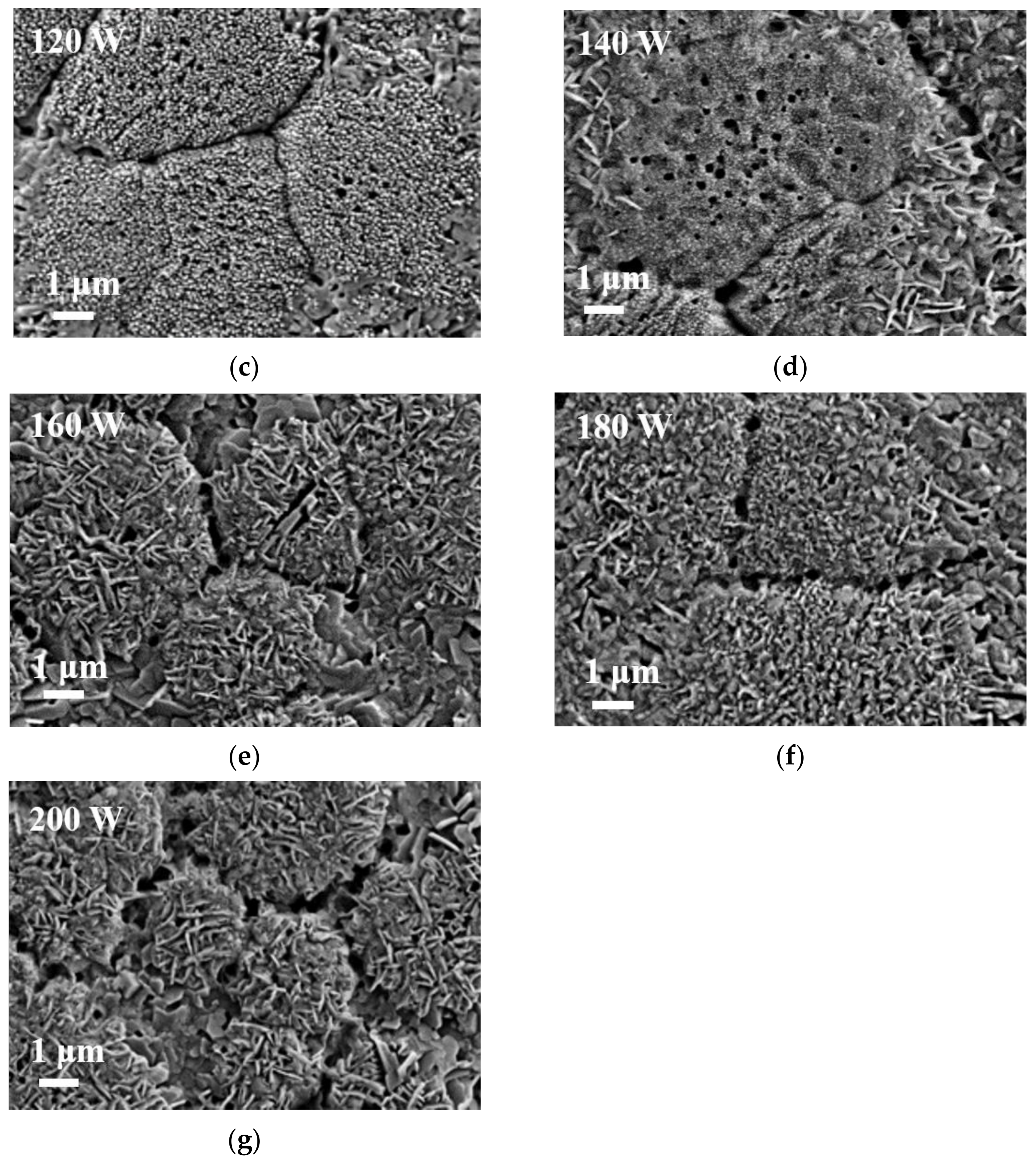
| Synthesis of CH3NH3PbI3 | Cs-Oleate Precursor | Synthesis of CsPbI3 QDs |
|---|---|---|
| CH3NH3I 198.75 mg | Cs2CO3 0.1 g | PbI2 0.173 g |
| GBL(C4H6O2) 0.5 mL | Oleic acid 0.5 mL | 1-octadecene 10 mL |
| PbI2 576.25 mg | 1-octadecene 10 mL | Oleic acid 1 mL |
| DMSO(C2H6OS) 0.5 mL | Oleyamine 1 mL | |
| Cs-oleate precursor 1.6 mL |
| Film | Power |
|---|---|
| MAPbI3 | 0 W |
| MAPbI3 with QDs | 0 W |
| MAPbI3 with QDs | 100 W |
| MAPbI3 with QDs | 120 W |
| MAPbI3 with QDs | 140 W |
| MAPbI3 with QDs | 160 W |
| MAPbI3 with QDs | 180 W |
| MAPbI3 with QDs | 200 W |
Publisher’s Note: MDPI stays neutral with regard to jurisdictional claims in published maps and institutional affiliations. |
© 2022 by the authors. Licensee MDPI, Basel, Switzerland. This article is an open access article distributed under the terms and conditions of the Creative Commons Attribution (CC BY) license (https://creativecommons.org/licenses/by/4.0/).
Share and Cite
Lien, S.-Y.; Liu, S.-Y.; Chen, W.-R.; Liu, C.-H.; Sze, P.-W.; Wang, N.-F.; Huang, C.-J. The Influence of Argon Plasma on Organic Perovskite MAPbI3 Film Doped with Inorganic Perovskite CsPbI3 Quantum Dots (QDs). Crystals 2022, 12, 799. https://doi.org/10.3390/cryst12060799
Lien S-Y, Liu S-Y, Chen W-R, Liu C-H, Sze P-W, Wang N-F, Huang C-J. The Influence of Argon Plasma on Organic Perovskite MAPbI3 Film Doped with Inorganic Perovskite CsPbI3 Quantum Dots (QDs). Crystals. 2022; 12(6):799. https://doi.org/10.3390/cryst12060799
Chicago/Turabian StyleLien, Shui-Yang, Shao-Yu Liu, Wen-Ray Chen, Chuan-Hsi Liu, Po-Wen Sze, Na-Fu Wang, and Chien-Jung Huang. 2022. "The Influence of Argon Plasma on Organic Perovskite MAPbI3 Film Doped with Inorganic Perovskite CsPbI3 Quantum Dots (QDs)" Crystals 12, no. 6: 799. https://doi.org/10.3390/cryst12060799
APA StyleLien, S.-Y., Liu, S.-Y., Chen, W.-R., Liu, C.-H., Sze, P.-W., Wang, N.-F., & Huang, C.-J. (2022). The Influence of Argon Plasma on Organic Perovskite MAPbI3 Film Doped with Inorganic Perovskite CsPbI3 Quantum Dots (QDs). Crystals, 12(6), 799. https://doi.org/10.3390/cryst12060799







